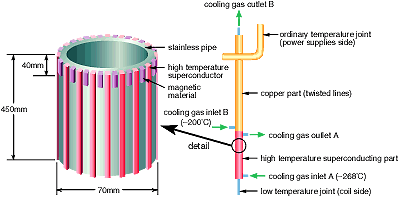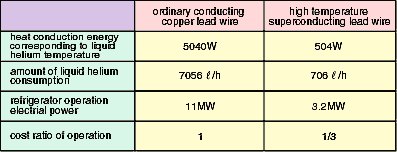| A superconducting magnet coil for a magnetic fusion reactor is covered
by a vacuum bottle so as to prevent heat entering from the outside,
and is cooled by liquid helium. An electric current lead wire is connected
to excite an electric current in the magnetic coil. So far, ordinary
copper has been used for the lead wire. In this case, it is impossible
to prevent heat entering from the outside, because the heat conduction
of copper is very large. This means we need more liquid helium consumption
to keep the coil at low temperature. A high temperature superconducting
material is a kind of ceramic. Therefore, heat conduction is very small.
On the other hand, there is difficulty in wiring high temperature superconducting
materials. Furthermore, self-quenching happens above a critical magnetic
field produced by its own large current. The conceptual structure of
a trial test piece and an arrangement of the wire connection are shown
in Fig. 2-20. Superconducting ceramic (Bi2223) is integrated with gold-added
silver substrates, and is made into a thin tape. Ferromagnetic materials
are used as protection against self-quenching. This lead wire shows
stable operation at the maximum 14 kA of electric current. Meanwhile,
the heat conduction rate is 1/10 the case of copper. We need a gas cooling
system for the lead wire. After all, the total refrigerator electricity
is 1/3 of the copper lead wire system. Comparison of both cases is shown
in Table 2-1 for the case of the ITER system. |

